Enviro
The idea is to introduce a new global currency that is working in parallel with all existing currencies of today.

Let’s call the new currency Enviro. Enviro´s shall represent the total usage of resources that has a negative impact on the sustainability of our planet. Each material that is extracted from the planet must be at a scientifically stated cost of enviros that is depending of the scarcity, the effect on the local environment and the method of extraction. The company extracting the material will of course need to pay Enviros for the equipment and energy that they purchase.
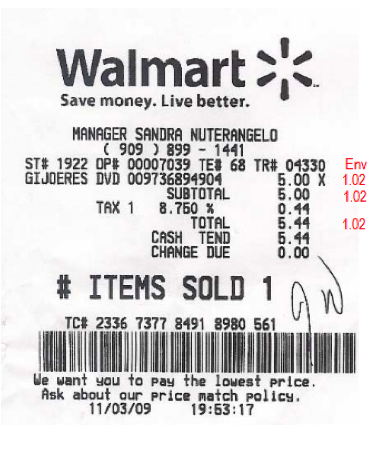
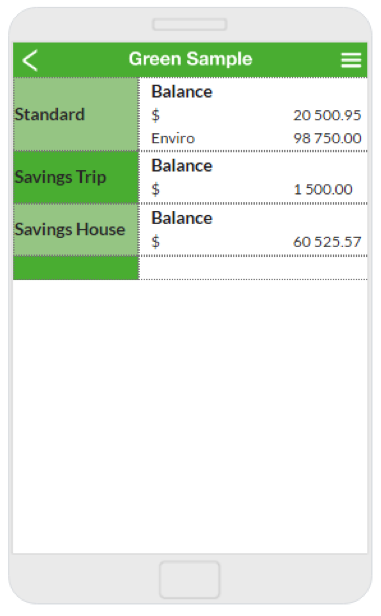
From a consumer perspective the complexity of living more environmental friendly would not be significantly higher that today. Each buying decision will be made with two values/currencies instead of one and your savings will also be presented in two currencies(red text on receipt in figure). The next figure is an example showing how a Bank app could present your accessible balance of dollars and Enviros
It is possible to compare this system with existing systems for VAT. Each party in the supplier chain, from the raw material to the end user, will need to pay Enviros and keep the balance between incoming and outgoing Enviros.
If we use oil as an example there will probably be different cost of extracting oil from oil sand in Canada or pumping it up from the northern Atlantic. The damage on the ecosystem may be different between the different cases: The usage of fresh water in Sahara may have a different cost than in Finland.
Example of production of a shelf

Let’s study an example of how Enviros may be used in the case of producing a shelf in teak for leisure boats. This is a simple example with only a few raw materials teak, glue and oil.
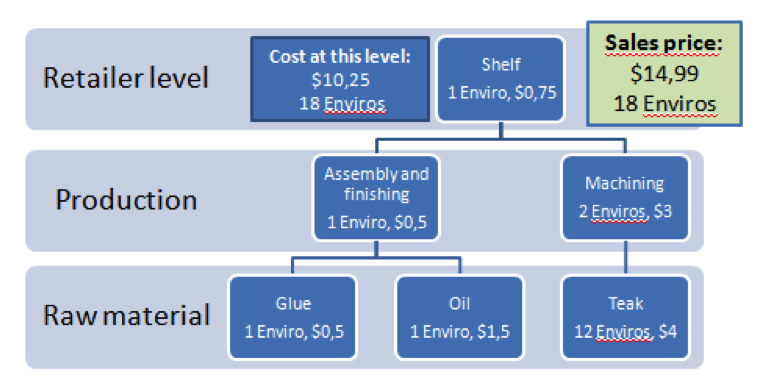
When the manufacturer of the shelf buy raw material they must pay with both standard currency (like $ for example) and Enviros. The oil and glue used for one shelf is just 1 Enviro each but teak has a bigger impact on the environment and therefore has a greater environmental cost. In this case we can assume that some old rainforest has been cut down which will have a negative impact on the natural production of oxygen and consumption of CO2.
During manufacturing the producer needs energy for the factory, grinding material will be consumed, machines will be used and some of its environmental cost will need to be depreciated on each product.
On the retailer level further environmental cost will be added in forms of transportation, energy consumption, packing material e t c.
When a boat owner wants to buy a new shelf he or she needs to check the balance of dollars as well as Enviros before making the purchase.
Accounting of Enviros
As mentioned earlier there are some similarities between the use of Enviro and VAT, both are a complement to actual cost and the balance between in and outflow must be closely monitored and reported to tax authorities.
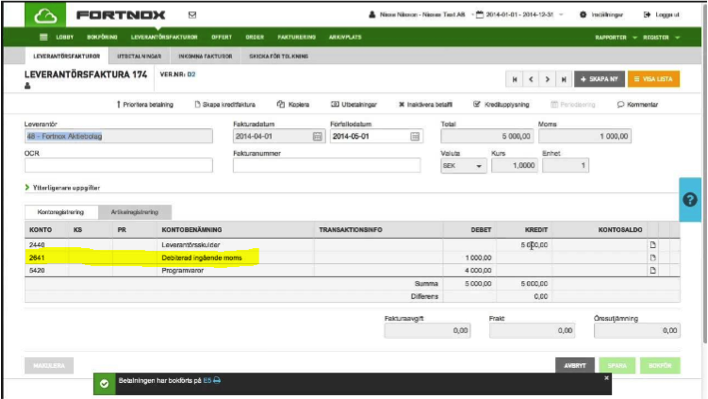
That means that financial staff just needs to add a couple of accounts to the existing set of accounts and then it will be possible to track transactions of Enviros between suppliers and customers.
In each management group meeting it will be of high interest to show both the financial status in ordinary currencies (like Dollars) and the balance of the Enviro account since that also is a scarce resource. In figure XX an example of a profit and loss report is shown where a new measure is introduced as an example, Enviros spent per revenue. All stock owners will compare the environmental efficiency between different companies
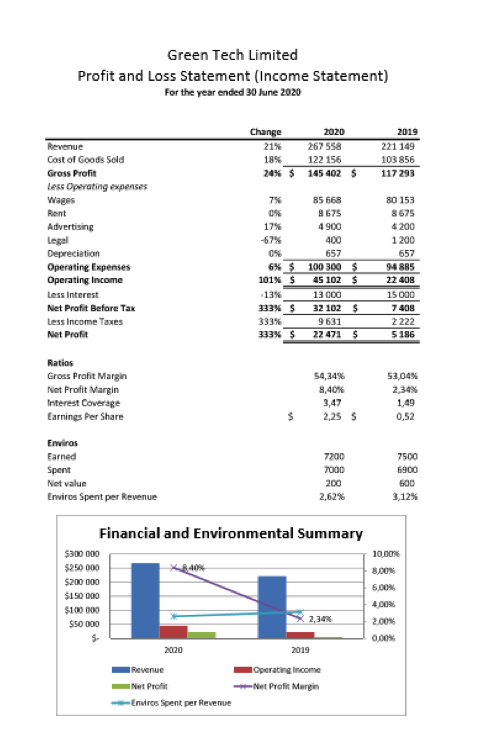
Each bank needs to be able to handle two parallel currencies on accounts and together with all financial transactions.
Global supply of Enviros
This part is on one hand the most obvious but on the other hand it may be the hardest one to get consensus about. The idea is that every year a fixed number of Enviros are released to the system and are evenly distributed to all adult citizens of the world. This is based on the assumption that every human being has the same right to exploit the limited resources that the planet has ability to support us with. This will of course raise the question if everybody has the same need to use recourses, but as will be later described it will be possible to trade Enviros for other currencies. You could argue that all citizens including children should get the same share of Enviros and that was also the initial thought, but I foresee that it may lead to some unwanted behaviors (like getting a lot of children to be able to trade Enviros).
By adding this new dimension to the market economy of the world it will now be possible to control the speed of extraction of limited rescores and the contribution of pollution. We hereby have the instrument to limit the usage to a sustainable level. It will also be extremely clear for all consumers if the use more or less of their share of the planets resources.
A side effect with this system is that it would be possible to earn extra Enviros by repairing the planets injuries. If somebody replant rain forest and thereby increase the planets capacity to handle CO2 Enviros may be earned. Another case could be new technology to save the environment, like the attempts to absorb CO2 from the atmosphere and store it blow ground.
Establish cost of environmental usage
There needs to be a politically independent research board of environmental researchers that continually work with the cost of using our environmental resources. This work may start on a basic level with the facts that are known today, for example it may be wise to start with energy production and define costs for coal, oil, gas e t c. and then improve the model. The future will tell what level of resolution we need to keep the planet and its citizens healthy. In the end it would be possible to put cost on every usage but the system and administration would be huge.
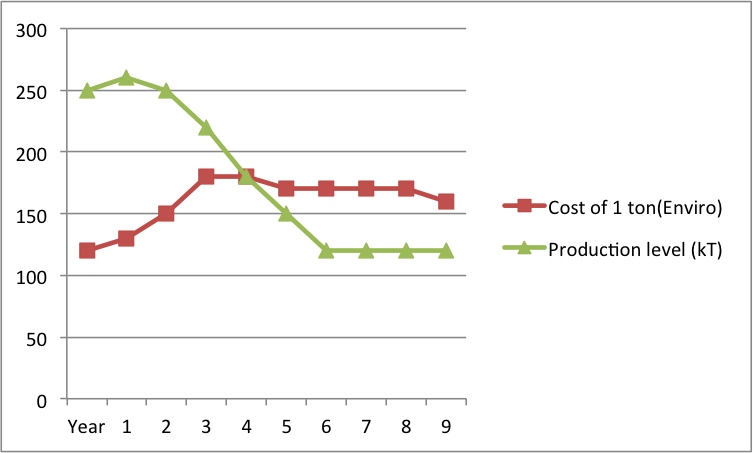
The research board and its deliveries will have a huge impact on the world economy and a lot of global enterprises will be economically dependent on the results from their work. This have some major implications, a lot of stakeholders could earn huge amount of capital if the cost of a resource is defined lower (than it actual effect on the environment) thus it is a high risk of bribery.
Trading Enviros
A lot of wealthy people in the world will be short on Enviros if they want to maintain their standard of living and a lot of people that are living environmental friendly will have a surplus. This will be the base for a trading market for Enviros where the surplus can be sold on a global market. This will probably have a small equalizing effect on the gap between rich and poor on our planet.

It is more common that countries with a high GDP per capita also produce more consuming based CO2 per capita (see figure).
To reduce the risk of going bankrupt on Enviros a method could be to restrict the sellable amount to the surplus of one or two years earlier.
Consequences
Reduction of the usage of environmental resources to a sustainable level
All people of the world will be provided with a base asset, their right to use resources of our planet.
It will stimulate green innovations since everybody will be able to calculate the cost of using the environment.
Recycling and reuse are stimulated.
Thank you for reading, I hope that you found it interesting and would be very grateful if you could help me with some feedback.